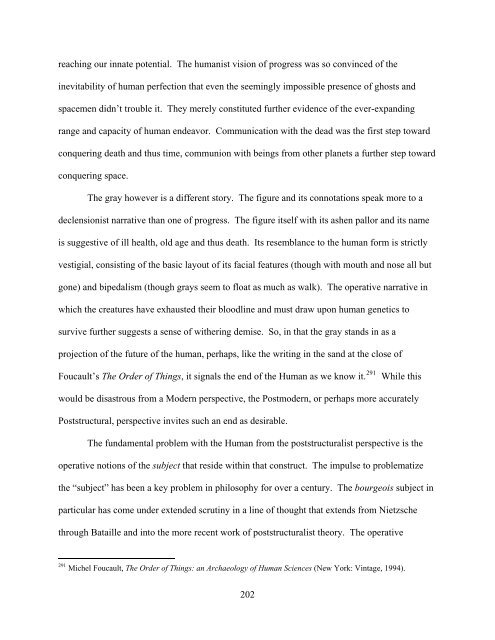A Genealogy of the Extraterrestrial in American Culture
A Genealogy of the Extraterrestrial in American Culture
A Genealogy of the Extraterrestrial in American Culture
Create successful ePaper yourself
Turn your PDF publications into a flip-book with our unique Google optimized e-Paper software.
each<strong>in</strong>g our <strong>in</strong>nate potential. The humanist vision <strong>of</strong> progress was so conv<strong>in</strong>ced <strong>of</strong> <strong>the</strong><br />
<strong>in</strong>evitability <strong>of</strong> human perfection that even <strong>the</strong> seem<strong>in</strong>gly impossible presence <strong>of</strong> ghosts and<br />
spacemen didn’t trouble it. They merely constituted fur<strong>the</strong>r evidence <strong>of</strong> <strong>the</strong> ever-expand<strong>in</strong>g<br />
range and capacity <strong>of</strong> human endeavor. Communication with <strong>the</strong> dead was <strong>the</strong> first step toward<br />
conquer<strong>in</strong>g death and thus time, communion with be<strong>in</strong>gs from o<strong>the</strong>r planets a fur<strong>the</strong>r step toward<br />
conquer<strong>in</strong>g space.<br />
The gray however is a different story. The figure and its connotations speak more to a<br />
declensionist narrative than one <strong>of</strong> progress. The figure itself with its ashen pallor and its name<br />
is suggestive <strong>of</strong> ill health, old age and thus death. Its resemblance to <strong>the</strong> human form is strictly<br />
vestigial, consist<strong>in</strong>g <strong>of</strong> <strong>the</strong> basic layout <strong>of</strong> its facial features (though with mouth and nose all but<br />
gone) and bipedalism (though grays seem to float as much as walk). The operative narrative <strong>in</strong><br />
which <strong>the</strong> creatures have exhausted <strong>the</strong>ir bloodl<strong>in</strong>e and must draw upon human genetics to<br />
survive fur<strong>the</strong>r suggests a sense <strong>of</strong> wi<strong>the</strong>r<strong>in</strong>g demise. So, <strong>in</strong> that <strong>the</strong> gray stands <strong>in</strong> as a<br />
projection <strong>of</strong> <strong>the</strong> future <strong>of</strong> <strong>the</strong> human, perhaps, like <strong>the</strong> writ<strong>in</strong>g <strong>in</strong> <strong>the</strong> sand at <strong>the</strong> close <strong>of</strong><br />
Foucault’s The Order <strong>of</strong> Th<strong>in</strong>gs, it signals <strong>the</strong> end <strong>of</strong> <strong>the</strong> Human as we know it. 291<br />
While this<br />
would be disastrous from a Modern perspective, <strong>the</strong> Postmodern, or perhaps more accurately<br />
Poststructural, perspective <strong>in</strong>vites such an end as desirable.<br />
The fundamental problem with <strong>the</strong> Human from <strong>the</strong> poststructuralist perspective is <strong>the</strong><br />
operative notions <strong>of</strong> <strong>the</strong> subject that reside with<strong>in</strong> that construct. The impulse to problematize<br />
<strong>the</strong> “subject” has been a key problem <strong>in</strong> philosophy for over a century. The bourgeois subject <strong>in</strong><br />
particular has come under extended scrut<strong>in</strong>y <strong>in</strong> a l<strong>in</strong>e <strong>of</strong> thought that extends from Nietzsche<br />
through Bataille and <strong>in</strong>to <strong>the</strong> more recent work <strong>of</strong> poststructuralist <strong>the</strong>ory. The operative<br />
291 Michel Foucault, The Order <strong>of</strong> Th<strong>in</strong>gs: an Archaeology <strong>of</strong> Human Sciences (New York: V<strong>in</strong>tage, 1994).<br />
202















